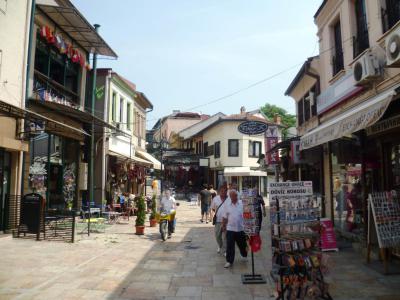
Old Bazaar, Skopje (must see)
Skopje's Old Town, often referred to as the Old Bazaar, is a historic gem located on the opposite side of the Vardar River. It stands as a testament to the rich and diverse history of the region and is considered the second-largest bazaar in Europe after Istanbul.
The roots of the Old Bazaar date back to the 12th century when it emerged as a merchant quarter. During the period of Ottoman rule in Skopje, the Old Bazaar flourished and rapidly developed into the city's primary center of commerce. The Ottoman influence is prominently displayed through around thirty mosques, numerous caravanserais, hans (inns), and other significant buildings and monuments that dot the landscape. The bazaar has endured various challenges, including the devastating earthquake of 1555, the burning of the city in 1689, another earthquake in 1963, as well as damage during the First and Second World Wars. Despite these hardships, the Old Bazaar has faced numerous rebuildings and remained a resilient symbol of Skopje's history.
The Old Bazaar is not only an essential marketplace but also a repository of cultural and historical significance. While Ottoman architecture predominantly characterizes the area, traces of Byzantine architectural elements can also be discerned. Recent reconstruction efforts have introduced modern architectural elements, creating a unique blend of styles.
Amidst the bustling marketplace, visitors can explore the remains of roughly thirty mosques, türbes (mausoleums), two churches, and a clocktower. These architectural wonders, together with the Museum of the Republic of North Macedonia and the Museum of Modern Art, form the core of the modern bazaar.
In recent years, there has been a growing interest in promoting the Old Bazaar as a prominent tourist attraction. The Macedonian Parliament recognized the Old Bazaar as cultural heritage of particular importance, passing a law in 2008 to ensure its permanent protection. A government-led project for the revitalization of the Old Bazaar was initiated in 2010, with a focus on restoring key structures and furthering the area's economic and cultural development. This initiative aims to preserve and celebrate the historical and cultural significance of Skopje's Old Town, inviting visitors to explore its rich heritage.
The roots of the Old Bazaar date back to the 12th century when it emerged as a merchant quarter. During the period of Ottoman rule in Skopje, the Old Bazaar flourished and rapidly developed into the city's primary center of commerce. The Ottoman influence is prominently displayed through around thirty mosques, numerous caravanserais, hans (inns), and other significant buildings and monuments that dot the landscape. The bazaar has endured various challenges, including the devastating earthquake of 1555, the burning of the city in 1689, another earthquake in 1963, as well as damage during the First and Second World Wars. Despite these hardships, the Old Bazaar has faced numerous rebuildings and remained a resilient symbol of Skopje's history.
The Old Bazaar is not only an essential marketplace but also a repository of cultural and historical significance. While Ottoman architecture predominantly characterizes the area, traces of Byzantine architectural elements can also be discerned. Recent reconstruction efforts have introduced modern architectural elements, creating a unique blend of styles.
Amidst the bustling marketplace, visitors can explore the remains of roughly thirty mosques, türbes (mausoleums), two churches, and a clocktower. These architectural wonders, together with the Museum of the Republic of North Macedonia and the Museum of Modern Art, form the core of the modern bazaar.
In recent years, there has been a growing interest in promoting the Old Bazaar as a prominent tourist attraction. The Macedonian Parliament recognized the Old Bazaar as cultural heritage of particular importance, passing a law in 2008 to ensure its permanent protection. A government-led project for the revitalization of the Old Bazaar was initiated in 2010, with a focus on restoring key structures and furthering the area's economic and cultural development. This initiative aims to preserve and celebrate the historical and cultural significance of Skopje's Old Town, inviting visitors to explore its rich heritage.
Want to visit this sight? Check out these Self-Guided Walking Tours in Skopje. Alternatively, you can download the mobile app "GPSmyCity: Walks in 1K+ Cities" from Apple App Store or Google Play Store. The app turns your mobile device to a personal tour guide and it works offline, so no data plan is needed when traveling abroad.
Old Bazaar on Map
Sight Name: Old Bazaar
Sight Location: Skopje, Macedonia (See walking tours in Skopje)
Sight Type: Shopping
Guide(s) Containing This Sight:
Sight Location: Skopje, Macedonia (See walking tours in Skopje)
Sight Type: Shopping
Guide(s) Containing This Sight:
Walking Tours in Skopje, Macedonia
Create Your Own Walk in Skopje
Creating your own self-guided walk in Skopje is easy and fun. Choose the city attractions that you want to see and a walk route map will be created just for you. You can even set your hotel as the start point of the walk.
Skopje Introduction Walking Tour
Unlike many other Balkan capitals such as Belgrade, Sofia, and Zagreb, which only grew to importance during the 19th century, the capital of North Macedonia, Skopje, is an ancient city dating back several millennia. As such, the city has many fascinating and often contradicting cultural and historical layers detectable in everything, from the architecture to the food to the language.
The name... view more
Tour Duration: 2 Hour(s)
Travel Distance: 2.1 Km or 1.3 Miles
The name... view more
Tour Duration: 2 Hour(s)
Travel Distance: 2.1 Km or 1.3 Miles
Useful Travel Guides for Planning Your Trip
Top 12 Balkan Foods to Try in Skopje
Are you planning to go to Skopje and want to experience some of the Balkan cuisines? Here are our top 12 recommendations, depending on the month of the...


